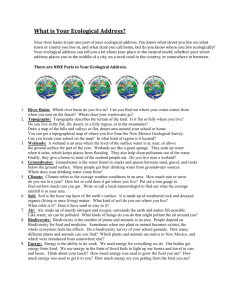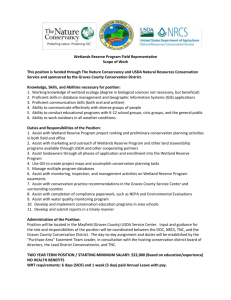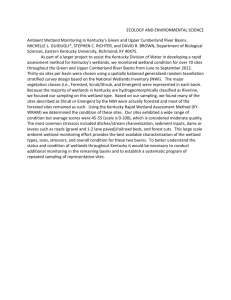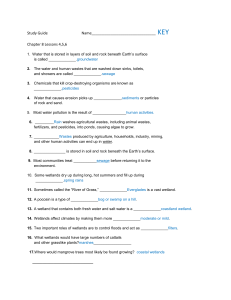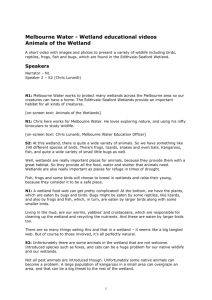SECTION E: PROCEDURE FOR INTERMEDIATE
advertisement
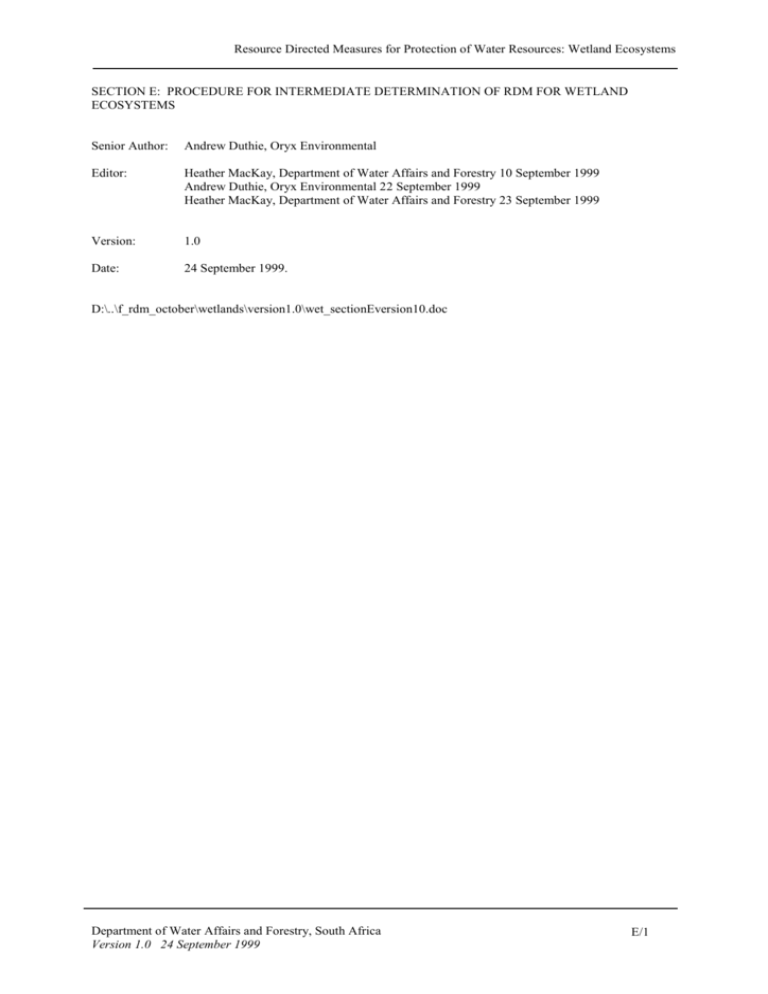
Resource Directed Measures for Protection of Water Resources: Wetland Ecosystems SECTION E: PROCEDURE FOR INTERMEDIATE DETERMINATION OF RDM FOR WETLAND ECOSYSTEMS Senior Author: Andrew Duthie, Oryx Environmental Editor: Heather MacKay, Department of Water Affairs and Forestry 10 September 1999 Andrew Duthie, Oryx Environmental 22 September 1999 Heather MacKay, Department of Water Affairs and Forestry 23 September 1999 Version: 1.0 Date: 24 September 1999. D:\..\f_rdm_october\wetlands\version1.0\wet_sectionEversion10.doc Department of Water Affairs and Forestry, South Africa Version 1.0 24 September 1999 E/1 Resource Directed Measures for Protection of Water Resources: Wetland Ecosystems Section E: Procedure for Intermediate Determination of RDM for Wetland Ecosystems (IER) E.1 Overall approach The Intermediate Ecological Reserve determination (Figure E1) should typically take no longer than two months to complete from the date of commission. Many seasonal wetlands are dry for a large part of the hydrological year and the assessment may therefore occur outside of the wet season. Consequently, the IER is based on hydrological, soil and vegetation indicators of wetland inundation and saturation requirements. The end of the wet season is likely to be the most favourable time for habitat and hydraulics assessments. For dry season assessments information on biota should be obtained from whatever sources possible or extrapolated from studies of similar ecotypes. E.2 Delineate boundaries of significant water resources Once the study area has been defined by the Department of Water Affairs and Forestry, it is broken down into water resource units that are each sufficiently different from the other to warrant their own specification of the reserve. The wetland team leader identifies wetlands within the study area using maps and aerial photographs of appropriate scale and collects all available information on these wetlands (See Section B, Table B1). This work should be undertaken in collaboration with the team leaders of the groundwater, river and estuary components of the Reserve. The wetland delineation methodology of Marnewecke and Kotze (Appendix W6) can then be used to delineate the geographic boundaries of these wetlands and the various vegetation and saturation zones within the wetlands. Map these zones in conjunction with topographical survey of the wetlands for hydraulic modelling purposes to ensure that the zones are linked to the same datum as the model. E.3 Determine the ecoregional type of each water resource unit The purpose of this step is to group the wetlands in the study area into “ecotypes” with similar physical, chemical and biological characteristics for the purposes of comparison and extrapolation. Ecotyping of the wetlands also provides the basis for deciding which components of the Reserve should be integrated with the wetland reserve and the methodology to be followed. For ecoregion levels I and II, use ecotyping of rivers shown in Rivers Appendix R4. For Ecoregion level III, use the Lacustrine, Palustrine and Endorheic classification in the proposed national wetland classification of Dini, Cowan & Goodman (1999) shown in Appendix W1. The ecotyping should also be used to identify which methodology should be adopted to determine the Reserve: a) If the wetland is a Lacustrine or Endorheic wetland (e.g. Lake or Pan) then the Lakes Present Ecological Status, Ecological Sensitivity and Importance and Ecological Management Class tools should be used or adapted according to site conditions (Appendix W3); or b) If the wetland is a Palustrine wetland then the Present Ecological Status, Ecological Sensitivity and Importance and Ecological Management Class tools should be used or adapted according to site conditions (Appendices W4 & W5). Department of Water Affairs and Forestry, South Africa Version 1.0 24 September 1999 E/2 Resource Directed Measures for Protection of Water Resources: Wetland Ecosystems 1. Initiate RDM study - Delineate geographical boundaries - Select RDM level & components - Establish study team composition 2a. Determine ecoregional types 2b. Delineate resource units 2c. Select sites for RDM study 3. Determine resource quality reference conditions 4a. Determine present status of resource units - Ecological status & resource quality - Water uses - Land uses, socio-economic conditions 5b. Set management classes for resource units: - Ecosystem protection - BHN protection - Water users’ protection 6a. Quantify Reserve for each resource unit: - determine water quantity - determine water quality - integrate quantity and quality - integrate river/wetland/groundwater/ estuary components 4b. Determine importance of resource units: - Ecological importance & sensitivity - Social importance - Economic importance 5a. Determine ecological management for resource units: classes - Importance - Sensitivity - Achievability Check implications of desired class for Reserve and RQOs before finally setting class 6b. Set RQOs for each resource unit using rules for selected classes: - habitat, biota, water uses, land based activities 7. Design appropriate resource monitoring programme 8. Publish notice of RDM determination, allow comment if necessary 9. Give effect to RDM determination - Develop strategy for achieving class, Reserve and RQOs - Draw up Catchment Management Strategy & implement 10. Monitor resource status and response to RDM implementation Figure E1: Generic RDM Flow Diagram. Department of Water Affairs and Forestry, South Africa Version 1.0 24 September 1999 E/3 Resource Directed Measures for Protection of Water Resources: Wetland Ecosystems E.4 Determine the reference conditions The purpose of this step is to describe, narratively, or where possible quantitatively, the “natural unimpacted” conditions of the wetland. The primary purpose of this exercise is to establish a baseline against which present conditions can be evaluated with a view to setting an Ecological Management Class. Where anthropogenic impacts have occurred, the reference conditions prior to the impacts should be described as far as possible. The reference conditions may have to be reset to new conditions where severe modification has happened and the ecological functions of the resource have been irreversibly altered or lost. In the absence of knowledge about the natural, unimpacted conditions of the resource, it may be necessary to set the present status as equivalent to the reference conditions.. Reference conditions should be described at the appropriate level of detail for the following aspects: Geomorphology: Terrain unit, landform, substrate type, substrate erodibility, sediment dynamics. Hydrology: Water source, hydrodynamics, wet periods, dry periods, saturation zones, surface water levels, groundwater levels, extent, period and depth of inundation, flow volumes, return periods of flows. Water chemistry: Temperature, Dissolved Oxygen, Electrical conductivity, TDS, pH, turbidity, TSS, nutrients, toxic constituents. Biological attributes: Vegetation communities and zonation, Fauna communities and spatial and temporal distribution. Occurrence of threatened species. E.5 Determine the Present Ecological Status The method for assessing the Present Ecological Status (PES) of wetlands (Appendix W4; section G for lakes) is based on that developed by Kleynhans (1999) for determining the habitat integrity of rivers. The methods estimate the degree of habitat integrity on the basis of anthropogenic change. A qualitative assessment is made of the changes to wetland hydrology, water quality, geomorphology, vegetation and fauna using indicators of such change. On the basis of this assessment, the wetland is classified on a scale from natural unmodified to completely modified and assigned a Present Ecological Status class, according to the classification described in W4, and in Section G for lakes. E.6 Determine the Ecological Management Class The Ecological Management Class (EMC) is set on the basis of the PES using the Ecological Importance and Sensitivity of the resource as a potential modifier to set a higher level of management status. Methodologies for determining the Ecological Importance and Sensitivity for the various types of wetlands are given in Appendices W4, and in Section G for lakes. The procedure and rules for selection of the EMC are described briefly in section A and in detail in the Classification System document. E.7 Set the Reserve E7.1 Wetland Reserve Water Quantity Component To quantify the water quantity component of the Reserve for the wetlands in question the following procedure should be followed: a) Identify those components of the habitat and biota that are critical to the maintenance of the chosen management class of the wetland. In the case of the IER water requirements will be determined primarily on the basis of the saturation, inundation and vegetation zones identified; b) Assess the water requirements of these components in terms of period, depth, extent, timing and frequency of inundation; Department of Water Affairs and Forestry, South Africa Version 1.0 24 September 1999 E/4 Resource Directed Measures for Protection of Water Resources: Wetland Ecosystems c) Link the requirements in (b) to surface and geohydrology through appropriate hydraulic and water balance models; and d) Determine the Reserve quantity in terms of the water required within the wetland and its delivery to the wetland (e.g groundwater, river flow or surface run-off; seasonality etc). The latter is essential for integration with other components of the Reserve. For example, channel maintenance by the River component is critical to the long term maintenance of the floodplain. E7.2 Wetland Reserve Water Quality Component The water quality component of the Reserve for wetlands should be set on the following basis: a) For Palustrine wetlands fed by river base-flow and flood-flow the same rules as those developed for rivers (see Rivers Appendix R20) may be used to determine the water quality Reserve until such time as wetlandspecific water quality rules are developed. Special attention should be given to the sediment requirements of floodplains; b) For lakes and pans additional attention must be given to the accumulation of toxic elements in these systems. The elevation of TDS and nutrient levels due to evaporation from these closed or semi-closed systems and limitations on mixing and dilution should also be considered. E7.3 Resource Quality Objectives for Wetlands Use as a guideline the procedures for setting resource quality objectives for rivers. E.8 Prepare an Integrated IER Notice The team leaders of the various components prepared an IER notice for each significant water resource that sets out the Resource Quality Objectives for the resource, and which integrates the river, wetland, groundwater and estuarine components as appropriate. If this is a reserve determination under section 16 of the Water Act, then the IER notice is submitted to the Minister of Water Affairs and Forestry and published in the Government Gazette to provide interested and affected parties with opportunity to comment. The IER notice may be revised on the basis of the comments. If this is a preliminary determination of the reserve under section 17 of the Water Act, then the reserve determination is published as a Department paper. E.9 Monitoring and Review A monitoring programme is then designed and implemented with the objectives of: collecting data to improve the confidence of the IER and/or to support the CER determination later; establishing whether the Reserve is being met and if the management actions and controls are adequate; establishing whether the Reserve and RQO are adequate and appropriate to support the habitat and biota at the level of protection required by the EMC. Department of Water Affairs and Forestry, South Africa Version 1.0 24 September 1999 E/5
